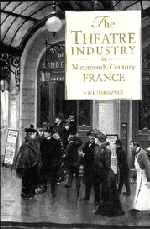Book contents
- Frontmatter
- Contents
- Chronology
- Introduction
- PART I THE AUDIENCES
- 1 Going to the theatre in the nineteenth century
- 2 The auditorium
- 3 Performance times – intervals – annual closures
- 4 First nights and previews
- 5 Order and disorder in the theatres
- 6 Applause and censure
- 7 The claque
- 8 Working-class audiences
- PART II THE ACTING PROFESSION
- PART III THE PROFESSION OF PLAYWRIGHT
- Notes
- Bibliography
- Guide to further reading
- Index
3 - Performance times – intervals – annual closures
Published online by Cambridge University Press: 07 December 2009
- Frontmatter
- Contents
- Chronology
- Introduction
- PART I THE AUDIENCES
- 1 Going to the theatre in the nineteenth century
- 2 The auditorium
- 3 Performance times – intervals – annual closures
- 4 First nights and previews
- 5 Order and disorder in the theatres
- 6 Applause and censure
- 7 The claque
- 8 Working-class audiences
- PART II THE ACTING PROFESSION
- PART III THE PROFESSION OF PLAYWRIGHT
- Notes
- Bibliography
- Guide to further reading
- Index
Summary
In past times, going to the theatre had always been regarded as an essentially social rite to be performed after the equally important family rite of the dinner hour, and since the latter fell later and later all through the period under discussion here, so the timing of performances had necessarily to move to accommodate the eating habits of spectators. In the eighteenth century, when sunrise signalled the start of the day's business, the main meal was taken in the early afternoon; theatrical performances for the leisured classes therefore started around 4.0 p.m. and finished four hours later; it was customary to partake of a light supper between 9.0 and 10.0 in the evening. During the Revolution, possibly to accommodate the lengthy sessions of the clubs and legislative assemblies whose debates were eagerly followed by the general public, the dinner hour and in consequence the hour fixed for the start of theatrical performances were postponed until the late afternoon. In 1802, an English visitor to France explained that ‘no genteel family at Paris dines before four or five o'clock, and some persons not till six or seven … The theatres commence at seven, and are generally over between ten and eleven.’ Combating this tendency for a later start were the requirements of a growing number of lower-class families who, with the rise in wages, were able to make a practice of spending an occasional evening at the theatre; they needed to be at work shortly after daybreak and so expected the curtain to rise at an earlier hour, 6.0 p.m., 5.30 p.m. or even 5.0 p.m., to enable them to be in bed at a reasonable hour.
- Type
- Chapter
- Information
- The Theatre Industry in Nineteenth-Century France , pp. 47 - 65Publisher: Cambridge University PressPrint publication year: 1993



